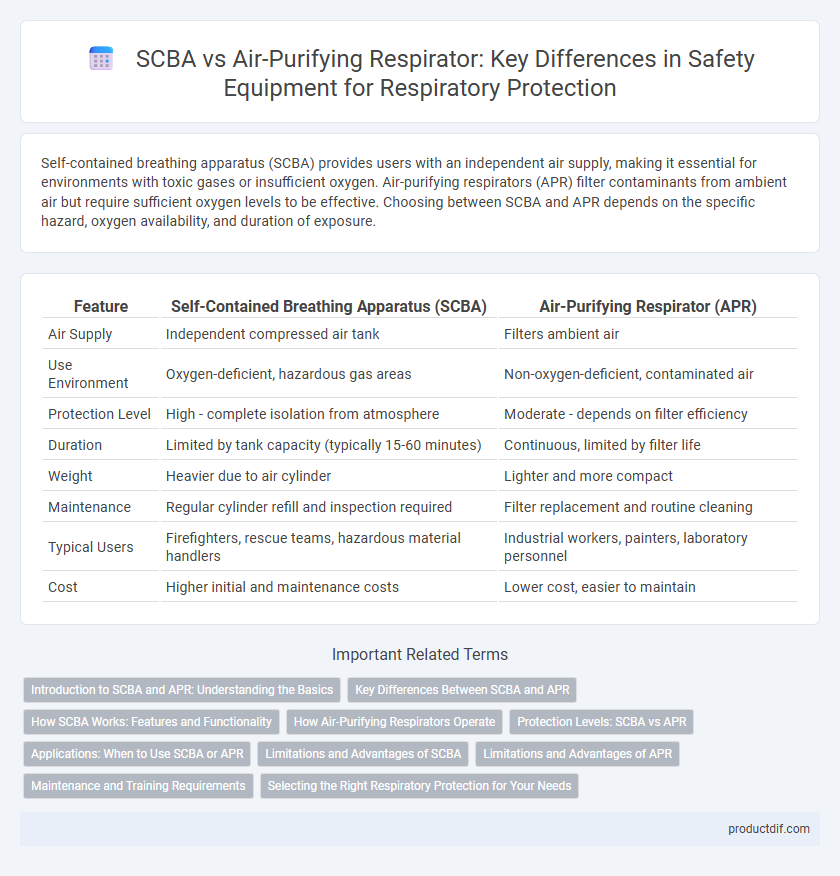Self-contained breathing apparatus (SCBA) provides users with an independent air supply, making it essential for environments with toxic gases or insufficient oxygen. Air-purifying respirators (APR) filter contaminants from ambient air but require sufficient oxygen levels to be effective. Choosing between SCBA and APR depends on the specific hazard, oxygen availability, and duration of exposure.
Table of Comparison
| Feature | Self-Contained Breathing Apparatus (SCBA) | Air-Purifying Respirator (APR) |
|---|---|---|
| Air Supply | Independent compressed air tank | Filters ambient air |
| Use Environment | Oxygen-deficient, hazardous gas areas | Non-oxygen-deficient, contaminated air |
| Protection Level | High - complete isolation from atmosphere | Moderate - depends on filter efficiency |
| Duration | Limited by tank capacity (typically 15-60 minutes) | Continuous, limited by filter life |
| Weight | Heavier due to air cylinder | Lighter and more compact |
| Maintenance | Regular cylinder refill and inspection required | Filter replacement and routine cleaning |
| Typical Users | Firefighters, rescue teams, hazardous material handlers | Industrial workers, painters, laboratory personnel |
| Cost | Higher initial and maintenance costs | Lower cost, easier to maintain |
Introduction to SCBA and APR: Understanding the Basics
Self-contained breathing apparatus (SCBA) provides users with a portable air supply, offering protection in environments with insufficient oxygen or high contamination levels, commonly used by firefighters and hazardous material responders. Air-purifying respirators (APR) rely on filters or cartridges to remove contaminants from ambient air, suitable for lower-risk situations with known airborne hazards. Understanding the operational differences, air source, and protection levels is essential for selecting the appropriate respiratory safety equipment for specific workplace conditions.
Key Differences Between SCBA and APR
Self-contained breathing apparatus (SCBA) provides breathable air from a pressurized tank, making it essential for environments with oxygen deficiency or highly toxic contaminants. Air-purifying respirators (APR) filter ambient air through cartridges to remove specific airborne hazards but rely on sufficient oxygen levels. SCBA offers superior protection in immediately dangerous to life or health (IDLH) conditions, whereas APRs are suitable for lower-risk environments with known and filtered contaminants.
How SCBA Works: Features and Functionality
Self-contained breathing apparatus (SCBA) provides breathable air from a high-pressure tank worn on the user's back, ensuring a reliable oxygen supply in hazardous environments. It features a face mask connected to a regulator that controls airflow, allowing the user to operate in oxygen-deficient or contaminated atmospheres. The airtight design and integrated alarms enhance safety by monitoring air supply levels and alerting the wearer to low pressure.
How Air-Purifying Respirators Operate
Air-purifying respirators (APRs) operate by filtering ambient air through replaceable cartridges or filters that remove contaminants such as dust, fumes, gases, and vapors before inhalation. These respirators rely on the surrounding atmosphere to supply breathable air, making them suitable for environments with sufficient oxygen levels and known airborne hazards. APRs are designed to protect against specific contaminants, requiring users to select appropriate cartridges based on the type of hazard encountered.
Protection Levels: SCBA vs APR
Self-contained breathing apparatus (SCBA) offers superior protection by providing a continuous supply of breathable air from a tank, making it suitable for environments with oxygen deficiency or high contaminant levels. Air-purifying respirators (APR) rely on filters to remove contaminants from ambient air but are ineffective in oxygen-deficient atmospheres or against certain gases and vapors. Consequently, SCBA is preferred for high-risk situations requiring maximum respiratory protection, while APR is limited to environments with adequate oxygen and known contaminant types.
Applications: When to Use SCBA or APR
Self-contained breathing apparatus (SCBA) is essential in environments with immediate danger to life or health, such as firefighting, confined space entry, and hazardous material responses where oxygen levels are insufficient or unknown. Air-purifying respirators (APR) are suitable for filtering contaminated air with adequate oxygen, commonly used in industrial settings like painting, pesticide application, and asbestos removal. Selecting SCBA or APR depends on oxygen availability, contaminant type, and exposure duration to ensure proper respiratory protection.
Limitations and Advantages of SCBA
Self-contained breathing apparatus (SCBA) provides independent, clean air supply, making it essential for environments with oxygen deficiency or unknown contaminants, ensuring maximum respiratory protection. Its limitations include heavier weight, limited air supply duration typically ranging from 15 to 60 minutes, and higher cost compared to air-purifying respirators (APR). Advantages of SCBA outweigh APR in hazardous conditions as it does not rely on ambient air quality and protects against a wider range of toxic gases and particulates.
Limitations and Advantages of APR
Air-purifying respirators (APRs) effectively filter out contaminants from ambient air, offering lightweight and cost-efficient protection compared to self-contained breathing apparatus (SCBA) which provide an independent air supply. APRs have limitations in environments with low oxygen levels, toxic gases, or unknown contaminants, as they rely on the quality of surrounding air and filter capacity. Their advantages include greater mobility, ease of use, and suitability for short-term exposure to specific airborne hazards where oxygen levels exceed 19.5%.
Maintenance and Training Requirements
Self-contained breathing apparatus (SCBA) demands rigorous maintenance including regular inspection, cylinder refilling, and functional testing to ensure reliable operation in hazardous environments. Training for SCBA users must be comprehensive, covering donning procedures, air management, and emergency protocols due to the complexity and life-dependent nature of the equipment. Air-purifying respirators (APR) require less intensive maintenance, mainly involving filter replacement and seal checks, while training focuses on proper fit, filter selection, and awareness of contaminant limitations.
Selecting the Right Respiratory Protection for Your Needs
Self-contained breathing apparatus (SCBA) provides independent air supply, making it ideal for environments with insufficient oxygen or unknown contaminants, while air-purifying respirators (APR) filter ambient air and are suitable for specific, known pollutants. Selecting the right respiratory protection depends on hazard type, oxygen levels, and exposure duration, as SCBAs offer robust protection in high-risk scenarios but are bulkier and more costly. For routine tasks involving regulated contaminants, APRs balance comfort and cost-effectiveness, but proper cartridge selection is critical for effective filtration.
Self-contained breathing apparatus (SCBA) vs Air-purifying respirator (APR) Infographic

 productdif.com
productdif.com